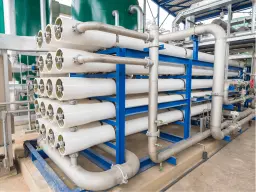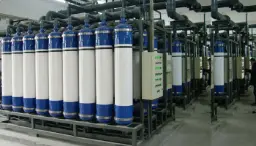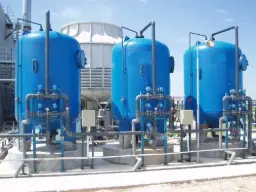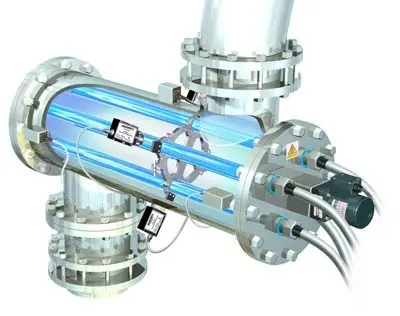Water Treatment for Hemodialysis Systems
High-quality water is fundamental to safe hemodialysis. During hemodialysis, a patient’s blood is circulated through a dialyzer where it is exposed to a semi-permeable membrane. On the other side of this membrane flows a carefully prepared dialysate containing water treated to an exceptionally high standard. By diffusive and convective transport, dissolved wastes and toxins move from the blood into the dialysate while essential electrolytes are balanced. The water used in this process is not ordinary potable water. The ultra‑pure water required for hemodialysis is produced through a sequence of treatment steps designed to remove dissolved salts, organic compounds, disinfectants such as chloramines, particulate matter, and microbial contaminants. Without such treatment, impurities could cross the membrane and enter the patient’s bloodstream, causing hemolysis, systemic inflammation or even death. The process involves municipal feed water entering a pretreatment chain to remove coarse contaminants, followed by polishing stages like reverse osmosis (RO), deionization (DI) and ultrafiltration, which produce water of extremely low conductivity and microbial load.
Beyond simply producing clean water, the water treatment system must deliver reliability and protect against variation in feed quality. Hospitals and dialysis centers often operate multiple machines simultaneously, with flow requirements ranging from a few hundred liters per hour to several thousand. If municipal supply quality changes suddenly due to line breaks or hyperchlorination events, there is risk of breakthrough of chlorine or chloramine into the product water. Operators monitor resistivity, total chlorine, total dissolved solids and microbial counts continuously to detect such changes. Adequate treatment directly impacts business value by reducing downtime, avoiding costly dialyzer damage and preventing adverse patient reactions. Inadequate removal of aluminum can lead to osteodystrophy, insufficient removal of chloramine can cause hemolytic anemia, and bacteria or endotoxin contamination can trigger pyrogenic reactions. The water treatment process therefore intervenes before the dialysis machine to mitigate these risks, providing a stable and safe foundation for patient therapy.
Related Products for Hemodialysis Water Treatment

Reverse Osmosis (RO)
Semi‑permeable polyamide membranes operating at 12–25 bar reject up to 99 % of dissolved salts, silica and organics, delivering low‑conductivity permeate suitable for high‑purity rinsing. RO is often configured in a two‑stage arrangement to achieve higher rejection and is the primary barrier for dissolved contaminants.

Ultrafiltration (UF)
Hollow‑fiber ultrafilters with molecular‑weight cutoffs of 20–30 kDa remove bacteria, endotoxins and colloidal particles from polished water. These filters operate at low pressure and are often installed just before the water distribution loop or on the dialysis machine inlet to ensure microbial purity.

Activated Carbon Filtration
Large carbon beds adsorb free chlorine, chloramine and low‑molecular‑weight organic compounds. Two carbon tanks are typically arranged in series to ensure complete removal, with empty bed contact times of 5–10 minutes at typical flow. The carbon also improves taste and odor but requires regular monitoring for breakthrough.

UV Sterilization
UV germicidal lamps emitting at 254 nm inactivate bacteria and some viruses in the water stream. UV reactors are positioned after carbon beds or storage tanks to control microbial growth. Although UV does not remove endotoxins, it reduces microbial proliferation in distribution loops.
A hemodialysis water treatment train typically combines these technologies in a carefully engineered sequence. Pretreatment steps such as multimedia filtration, softening and activated carbon protect RO membranes from fouling and chemical attack. Reverse osmosis provides the main removal of dissolved ionic and organic contaminants, while deionization and ultrafiltration polish the permeate to achieve the low conductivity and endotoxin specifications. Ultraviolet irradiation and periodic thermal or ozone disinfection prevent microbial colonization within the storage and distribution systems, which can lead to biofilm formation and endotoxin release. Each component addresses specific contaminant classes; together they provide redundancy and multiple barriers. For instance, dual carbon beds protect against chlorine breakthrough even if one tank becomes exhausted, while two‑pass RO or RO followed by DI ensures removal of both charged and neutral solutes. Careful integration of these systems ensures reliability and compliance with stringent dialysis water standards.
Key Water-Quality Parameters Monitored
Monitoring the quality of water produced for hemodialysis is a continuous and disciplined activity. Operators focus on chemical parameters that influence patient safety and equipment longevity. Conductivity and resistivity provide rapid feedback on the overall ionic content. Conductivity meters measure the ease with which water can carry an electrical current; lower values indicate fewer dissolved ions. Typically, post‑RO water should have conductivity below 10 µS/cm and post‑DI water often achieves below 1 µS/cm. Resistivity meters, the inverse of conductivity, display values above 0.1 MΩ·cm for RO permeate and above 1.0 MΩ·cm for polished water. Continuous resistivity alarms ensure that any rise in ionic content, perhaps from exhaustion of an ion‑exchange bed or membrane breach, is detected immediately. Hardness, defined by calcium and magnesium concentration, is maintained below 4 mg/L to prevent scale. pH is monitored to remain within 6.5–8.5, as extremes can damage membranes or cause patient electrolyte disturbances. Each of these parameters is measured with inline sensors or through bench analyses, and trends are logged to identify early signs of system deterioration.
Microbiological and endotoxin monitoring are equally important. Monthly total viable count (TVC) tests are performed on product water and dialysate using low‑nutrient media such as Reasoner’s 2A agar, with conventional action levels at 50 CFU/mL and maximum limits at 100 CFU/mL. For centers producing ultrapure dialysate, the target is <0.1 CFU/mL. Endotoxins are measured with the Limulus Amebocyte Lysate (LAL) test, with a typical allowable level below 0.25 EU/mL and an action level at 0.125 EU/mL. Total chlorine or chloramine monitoring is critical because residual disinfectants can cause hemolysis. Using colorimetric DPD test kits, total chlorine is tested before each shift between carbon tanks, ensuring levels remain below 0.1 mg/L, with action taken if readings exceed 0.05 mg/L. Temperature and flow velocity within the distribution loop are monitored continuously because stagnant or lukewarm conditions promote biofilm growth. Facilities record temperature logs to ensure recirculation typically stays between 20–25 °C during operation and reaches 80 °C during heat disinfection. These data sets feed into preventive maintenance programs that adjust backwash schedules, carbon tank changeouts and disinfection cycles.
| Parameter | Typical Range | Control Method |
| Conductivity/Resistivity | <10 µS/cm after RO; <1 µS/cm or >1 MΩ·cm after polishing | Inline conductivity/resistivity meters with alarms |
| Total Chlorine/Chloramine | <0.1 mg/L (action at ≥0.05 mg/L) | DPD colorimetric testing before each shift; dual carbon beds |
| Hardness (Ca + Mg) | <4 mg/L | Water softener regeneration and periodic hardness titration |
| pH | 6.5–8.5 | Inline pH sensors; acid/base dosing in pretreatment |
| Total Viable Count (TVC) | <100 CFU/mL (action at 50 CFU/mL); <0.1 CFU/mL for ultrapure | Monthly culture on R2A agar; sanitize loop if exceeded |
| Endotoxin | <0.25 EU/mL (action at 0.125 EU/mL) | LAL assay; periodic ultrafiltration and heat disinfection |
| Aluminum | <0.01 mg/L | RO removal with pre‑softening; monitor with ICP analysis |
| Calcium | <2 mg/L | Softener and RO; periodic atomic absorption testing |
| Sodium | <70 mg/L | RO; monitor by flame photometry |
| Free Chlorine (pre‑carbon) | <0.5 mg/L | DPD test; monitor municipal feed before carbon |
| Nitrate | <2.0 mg/L | RO and DI; periodic ion chromatography |
| Sulfate | <100 mg/L | RO; periodic sulfate ion testing |
| Flow velocity | 3–5 ft/s in loop | Flow meters; pump sizing and loop design |
| Temperature | 20–25 °C during dialysis; 80 °C during heat disinfection | Inline thermometers; heater control |
Design & Implementation Considerations
Designing a water treatment system for hemodialysis starts with a careful assessment of feed water quality and demand. Municipal water may vary widely in hardness, chlorine residual, microbiological content and seasonal temperature. Engineers sample the water over several weeks to understand worst‑case conditions. Based on this data, they size pretreatment components such as multimedia filters and softeners to handle peak flow while maintaining contact time. Hydraulic calculations ensure proper empty bed contact times in carbon tanks to completely remove chloramine; typically 10–15 minutes at design flow. Designers also account for redundancy; two carbon beds in series ensure that if the first becomes exhausted, the second provides protection. Reverse osmosis systems are often configured as two‑pass units to achieve higher rejection and allow for maintenance without stopping production. Determining whether to include mixed‑bed deionization depends on local requirements for resistivity and cost considerations. The distribution loop is designed as a continuous recirculation system with materials resistant to corrosion, such as medical‑grade PVC or stainless steel, and with minimal dead legs to discourage biofilm formation.
Compliance with recognized standards underpins system design. The ANSI/AAMI/ISO 13959 standard specifies chemical limits for dialysis water, while ANSI/AAMI/ISO 26722 defines requirements for water treatment equipment. These documents guide materials selection, instrumentation and validation procedures. Facilities must also comply with ISO 23500 for quality management of fluids for haemodialysis and associated therapies. In the European context, EN 15187 provides guidance on the treatment and distribution of water for hemodialysis. Designers incorporate sampling ports at strategic points—after pretreatment, after RO, at the end of distribution loops and at dialysis machine inlets—to facilitate compliance testing. Pressure gauges across filters and membranes allow operators to track differential pressure and detect fouling. Resistivity and conductivity meters are located downstream of critical barriers with alarm capabilities that trigger system shutdown if quality thresholds are exceeded. Automated data logging helps demonstrate compliance during audits by regulatory bodies. The system layout also considers future expansion; by incorporating modular RO skids and manifolded pumps, centers can add capacity without major reconfiguration.
Considerations extend beyond equipment selection. Sizing the storage tank, if one is used, requires balancing volume to meet short‑term demand with the desire to minimize water age and stagnation. Some facilities avoid tanks entirely by using direct feed systems where water flows directly to dialysis machines, reducing risk of biofilm growth. Where tanks are used, they are equipped with overflow protection, hydrophobic vent filters and sanitary spray balls for cleaning. Instrumentation selection prioritizes reliability and ease of calibration; for example, pH probes with automatic temperature compensation and resistivity meters with built‑in standard solution calibration routines. Control systems integrate sensors, valves and pumps into a coherent automation platform that can switch between operating and disinfection modes. A properly designed system also accounts for safety features such as fail‑safe shutoff valves that isolate machines when chlorine breakthrough occurs. Ergonomic considerations, including accessible sample taps and clear labeling, support safe operation by clinical staff who may not be water treatment experts. Finally, life‑cycle cost analysis influences decisions such as whether to invest in heat disinfection versus chemical disinfection, as energy costs and chemical handling requirements differ significantly.
Operation & Maintenance
Operating a dialysis water treatment system requires rigorous monitoring and adherence to maintenance schedules. Each pretreatment step must function correctly to protect downstream components. Operators perform daily checks of inlet water pressure, temperature and chloramine levels. If free chlorine or total chlorine levels approach 0.05 mg/L between carbon beds, they prepare to change or regenerate carbon. Softener brine tanks are inspected and replenished with salt pellets weekly, and hardness tests verify that effluent hardness remains below 4 mg/L. Reverse osmosis units require monitoring of inlet and concentrate pressures; differential pressure exceeding 20 % from baseline suggests membrane fouling. Operators measure permeate flow and calculate recovery to ensure performance within design range; typical recovery values lie around 75 %. Routine chemical cleaning of RO membranes is scheduled every three to six months depending on fouling rates. Mixed‑bed deionizers are monitored via resistivity meters; when resistivity falls below 0.1 MΩ·cm, resin regeneration or replacement is initiated. Filters such as depth cartridges or ultrafilters are replaced on monthly or quarterly intervals depending on manufacturer recommendations and test results.
Disinfection protocols are crucial to controlling microbial growth. Facilities implement monthly heat disinfection cycles in which product water is heated to 80 °C and circulated through the distribution loop for several hours. Where heat is impractical, chemical disinfection with peracetic acid, sodium hypochlorite or ozone is employed, ensuring that contact time and concentration achieve the necessary log reduction of bacteria and endotoxin. In some centers, ozone disinfection is performed weekly to keep biofilm accumulation low. After disinfection, operators flush the system thoroughly and verify that residual disinfectant levels are below 0.1 mg/L before resuming dialysis. Maintenance logs document each disinfection event, filter change, membrane cleaning and test result. Regular calibration of sensors ensures data accuracy; for example, conductivity meters are calibrated using annual traceable standards, and pH probes are calibrated daily or weekly depending on drift. Staff training is ongoing; they learn to interpret alarm conditions, perform troubleshooting and respond to emergencies such as chlorine breakthrough or microbial contamination. When alarms indicate potential contamination, procedures call for immediate cessation of dialysis and switching to an alternative water source or postponing treatments until corrective actions restore safety.
Challenges & Solutions
Water treatment for hemodialysis presents numerous technical and operational challenges. Problem: Variable feed water quality can overwhelm pretreatment systems. Municipal supplies may fluctuate in turbidity, temperature and chloramine concentration, especially during seasonal changes or disinfection events. Solution: Engineers design pretreatment with conservative capacities and install real‑time sensors to detect sudden changes. Having dual carbon beds with sufficient empty bed contact time provides resiliency against chloramine spikes. During hyperchlorination events, operators increase monitoring frequency and perform more frequent carbon sampling to catch breakthrough before patient exposure. Incorporating alarms tied to total chlorine measurements ensures immediate response.
Biofilm formation within distribution loops poses another persistent challenge. Problem: Warm, stagnant water encourages bacteria to attach to pipe surfaces and produce extracellular polymers that harbor endotoxins and resist disinfection. Solution: Facilities combat this by maintaining continuous recirculation with velocities between 3 and 5 feet per second. Using smooth, nonreactive materials and minimizing dead legs reduces sites where biofilm can establish. Regular thermal or ozone disinfection burns off developing biofilms and removes embedded endotoxins. Operators also sample distal points in the loop to verify that microbial counts remain below action levels and adjust cleaning frequency accordingly.
Chemical contaminant breakthroughs are a third concern. Problem: Exhaustion of softeners, DI resin or carbon beds can lead to spikes in calcium, magnesium, sodium or chloramine in the product water. Solution: Maintaining proper regeneration schedules, monitoring influent and effluent water quality and keeping spare resin canisters on hand enable quick replacement. Using automatic hardness analyzers and chlorine monitors provides continuous oversight. When breakthrough is detected, the system is placed in bypass or service is temporarily halted until the issue is corrected.
Equipment reliability also challenges dialysis centers. Problem: RO membranes foul or scale over time, resulting in reduced permeate flow and increased conductivity. Solution: Implementing preventative maintenance, including routine membrane cleaning and replacing pretreatment filters before their differential pressure rises excessively, prolongs membrane life. Operators track key performance indicators such as pressure drop and salt rejection to schedule interventions proactively. Upgrading to high‑flux membranes or employing antiscalant dosing may also reduce fouling rates.
Finally, staffing and training present challenges. Problem: Dialysis technicians may not receive extensive education in water treatment yet are responsible for monitoring critical parameters. Solution: Establishing comprehensive training programs, using clear standard operating procedures and providing ongoing continuing education improve competency. Some facilities adopt automated control systems with intuitive interfaces that guide operators through required checks. Remote monitoring systems send alerts to supervisors or vendors when parameters drift, ensuring issues are addressed promptly. By recognizing these challenges and applying targeted solutions, dialysis centers maintain safe and reliable water quality.
Advantages & Disadvantages
Providing ultra‑pure water for hemodialysis has clear advantages that justify the investment in sophisticated treatment systems. The greatest benefit is patient safety; removal of chemical contaminants prevents acute reactions such as hemolysis, bone disease and neurological deterioration. Lower microbial and endotoxin levels reduce chronic inflammatory responses and improve patient outcomes. Another advantage is the protection of dialysis machines and membranes; high‑quality water minimizes scaling, fouling and corrosion, thereby extending equipment life and reducing maintenance costs. High water quality also supports regulatory compliance, helping facilities meet national standards and avoid penalties. On the operational side, well‑designed systems can provide redundancy and reduce downtime, enabling centers to maintain schedules even during feed water fluctuations or component failures.
There are disadvantages to consider as well. The capital cost of equipment such as two‑pass RO systems, heat disinfection units and monitoring instrumentation can be significant, particularly for small clinics. Operational costs include energy for pumping and heating, consumables like filters and resin, and chemicals for disinfection. Systems require skilled staff to operate and maintain them, adding to labor costs. Disinfection, if not managed carefully, can contribute to equipment degradation; repeated high‑temperature cycles or strong oxidants may shorten the life of plastics and seals. Additionally, producing ultra‑pure water generates concentrate waste streams that carry rejected salts and chemicals back to the sewer, which can have environmental implications. While these disadvantages are real, they are typically outweighed by the necessity of providing safe dialysis treatments.
| Aspect | Pros | Cons |
| Patient safety | Ultra‑pure water prevents hemolysis, endotoxemia and chronic inflammation | Requires stringent monitoring to maintain standards |
| Equipment longevity | Reduced scaling and fouling lowers maintenance and replacement costs | High capital investment for RO, DI and disinfection units |
| Regulatory compliance | Aligns with AAMI/ISO standards, avoiding penalties | Compliance audits demand detailed documentation and testing |
| Operational resilience | Redundant systems and alarms minimize downtime | Skilled personnel needed; training requirements are high |
| Environmental impact | High‑purity water enables efficient dialysate preparation | Waste streams from RO reject may impact local wastewater systems |
Frequently Asked Questions
Question: Why is water purity so critical in hemodialysis?
Answer: Hemodialysis exposes patients to hundreds of liters of water each week via the dialysate. Contaminants present in untreated water can cross the dialyzer membrane and enter the bloodstream. Even low levels of chemicals like chloramines or aluminum can cause hemolytic reactions or bone disease. Microorganisms and endotoxins can trigger fever, inflammation and sepsis. Because patients’ kidneys cannot filter these substances, water quality must exceed drinking water standards to ensure safe treatment.
Question: How often should chlorine or chloramine levels be tested in dialysis water?
Answer: Total chlorine (the sum of free chlorine and chloramine) should be tested before each dialysis shift, typically every four hours when treatments run continuously. Samples are taken between the first and second carbon beds using DPD colorimetric test kits. If levels exceed 0.05 mg/L, action is taken immediately, such as replacing carbon or postponing treatment, to prevent patient exposure to residual disinfectants.
Question: What is the difference between reverse osmosis and deionization in dialysis water treatment?
Answer: Reverse osmosis uses a semi‑permeable membrane to remove dissolved ions, organics and microorganisms under pressure, rejecting most contaminants and producing low‑conductivity permeate. Deionization uses ion‑exchange resins to replace cations and anions in the water with hydrogen and hydroxide ions, effectively polishing the water to higher purity. RO is the primary barrier for removing bulk contaminants and is essential to protect patients from a wide range of impurities, whereas DI is an optional polishing step that may be used when extremely low conductivity is desired.
Question: How do facilities control bacterial and endotoxin growth in distribution loops?
Answer: Facilities employ continuous recirculation with high flow velocities to prevent stagnation. Loop materials are chosen to resist biofilm formation, and periodic disinfection is performed using heat or chemical agents. Ultrafiltration and ultraviolet irradiation at strategic points also reduce microbial loads. Regular sampling of distal loop points provides evidence of control, and when counts rise near action levels, disinfection frequency is increased to restore microbial stability.
Question: What happens if a water treatment system fails during dialysis treatments?
Answer: Modern systems incorporate alarms and automatic shutoff valves to prevent unsafe water from reaching patients. If conductivity or chlorine sensors detect a breach, the system stops delivering water to dialysis machines, and treatments are halted. Clinics typically have contingency plans, such as storing reserve volumes of high‑purity water or connecting portable RO units, to complete urgent treatments. The system is then inspected, components replaced or regenerated and water quality revalidated before resuming operations.
Calculation Example
To illustrate a practical calculation relevant to hemodialysis water treatment, consider determining permeate flow based on recovery in a two‑pass RO system. If the first pass operates at 75 % recovery and the feed flow is 800 L/h, the permeate flow is calculated using the recovery formula (permeate = feed × recovery). Inserting the values into this formula yields a permeate flow of 600 L/h.